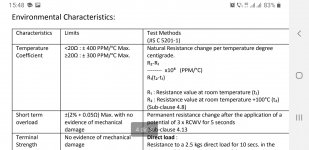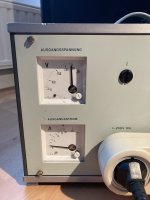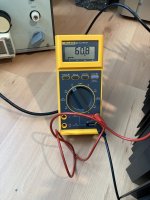dreamth, the amp in question was not tested at 240v and had the bias turned down. What is the problem?
S
So they're basically useless otherwise. If I us two 2000 Watts in parallel for a total of 4 kW at 4 Ohm with a maximum expected rating of 1200 Watts as specified, would that be sufficient?Maybe for 30 seconds at 2kwatts in parallel ...but you need to have them specd for a full 1000 watts/ 1 hour because that tells their resistance will not go up at 1000 watts. 4 of them will do for 8 ohms, 8 pcs for 4 ohms...a metrology lab would have them already if you can pay their bulletins 🙂
Makes little sense spending money more than absolutely minimum for a single use. Immersion heater and incandescent light in parallel should be safe and good enough.
If this amps were sold on the EU market they need to have 220 or 230 v AC input by law.I only advised for the amp to be reverted to its original state , then chequed , serviced and measured by an appropriate authority that can release a metrologic and service bulletin and we have a bunch of them in Europe that can do it.dreamth, the amp in question was not tested at 240v and had the bias turned down. What is the problem?
They are useless not just from a technical point of view, but also from a legal one.The resistors need to be specified for at least a continuous use of 1 hour at the maximum rated power that you intend to measure the amplifier on them if you want this to serve as evidence by the law.S
So they're basically useless otherwise. If I us two 2000 Watts in parallel for a total of 4 kW at 4 Ohm with a maximum expected rating of 1200 Watts as specified, would that be sufficient?
You want to prove the amp cannot deliver 1000 watts on 8 ohm load and 2000watts on 4 ohms load.So you need the load resistors to be specified by a well known manufacturer for those powers.
They are good enough for youtube videos filmed indoors, not to be presented as evidence in a court of law...Makes little sense spending money more than absolutely minimum for a single use. Immersion heater and incandescent light in parallel should be safe and good enough.
Subjecting a 1kW amp to 1kHz sinewave for an hour... with a 4 ohms load.
Is that what you 2 are suggesting/planning to do?
Is that what you 2 are suggesting/planning to do?
As already stated I'm not gonna sue anybody even if it can proven that the specs supplied by the manufacturer are dead wrong. I'm very satisfied with them they are an improvement on earlier designs like the Thresholds I had and the X600's. And I'm fond on people like NP and ZenMod that are always patiently willing to help a technical illiterate as I am.They are good enough for youtube videos filmed indoors, not to be presented as evidence in a court of law...
Haha, not me. I wish those amps to survive. Standard testing is as I remember before a powerrating test always an hour or half an hour at 33% of their nominal ratings and most amps become at that power pretty hot I think.Subjecting a 1kW amp to 1kHz sinewave for an hour... with a 4 ohms load.
Is that what you 2 are suggesting/planning to do?
Of course not.5 minutes would be absolutely sufficient.It's that there are legal requirements to prove power and 1 hour endurance for the test load is generally ok for audio equipment .Where I used to work in the past we had 3 minutes continuous power tests for up to 2000 watts lasers which ment a class C 81...100MHz RF amplifier and its smps power supply being tested at up to 100kWatts...then 72 hours power tests for 4...65kwatts smps supplies after 100 dead short tests at 300kV ...70cm plasma arc...then 10 miliseconds tests for 10...50 Megawatts x and gamma ray equipment, then up to 120 tests/minute of instantaneous surge of 13 MegWatts Nd-Yag femtosecond lasers...their liquid cooled power supplies used to deliver about 5 kilowatts of continuous power to charge the flash capacitors fast...and so on...Unfortunately I missed a job at Harwell LHC where I could make Gigawatts tests 🙂Subjecting a 1kW amp to 1kHz sinewave for an hour... with a 4 ohms load.
Is that what you 2 are suggesting/planning to do?
Last edited:
Yet many class AB power amplifiers service manuals asked for 30 minutes preheating before bias adjust...
Idling as I understand...Yet many class AB power amplifiers service manuals asked for 30 minutes preheating before bias adjust...
And it's a bit more tedious as I understand from the servicemanual:
These are the specs:They are good enough for youtube videos filmed indoors, not to be presented as evidence in a court of law...
https://www.te.com/commerce/Documen...&DocNm=9-1773453-2&DocType=DS&DocLang=English
one of them will do for a few kW if you put them outside immersed into a bucket with a garden hose running cold water over themMaybe for 30 seconds at 2kwatts in parallel ...but you need to have them specd for a full 1000 watts/ 1 hour because that tells their resistance will not go up at 1000 watts. 4 of them will do for 8 ohms, 8 pcs for 4 ohms...a metrology lab would have them already if you can pay their bulletins 🙂
It doesn't matter if you can make it work in a NASA lab, it matters if its specs right out of the batch are good enough.
There are rules by which you make accepable measurements...You need to read a lot on the subject before choosing your measurement equipment, loads...
There are rules by which you make accepable measurements...You need to read a lot on the subject before choosing your measurement equipment, loads...
Attachments
Tells enough of what kind a man you are dealing with. If bias has got nothing to do with it then no reason to waste so much power, turn quiescent down all the way.... Question: Also the measured 405 watts idle should be 600 watts according to the manufacturer. Maybe the distortion value of 1% is reached earlier, at a lower output power levels?
Answer: No, that has nothing to do with it! I have set the quiescent current in consultation with the customer, as far as I can remember.
Bias lugs should give 60mV's for the 600.5 according to ZenMod:
again from Book of Yore:
"The differential DC offset between the two outputs will be less than 50 mV.
The absolute DC offset between each output and ground will be less than 500 mV.
The bias voltage of each output stage (as measured between the wire loops on either
side of the terminal blocks on the motherboard going to the output stage) is 60 mV (+/-
10%)."
I'll will warm up first with the MM connected to the biaslugs with the lid on as much as possible and another MM connected to the output terminals to check DC. When making adjustments I will monitor the AC uptake in Watts
Initially:
With both sides the bias at 60mV as specified from the book of Yore the AC uptake is 420 Watts at 240 Volts and a 65 Volts rail...



Should I increase the bias Evenly of course to get to 600 Watts?
again from Book of Yore:
"The differential DC offset between the two outputs will be less than 50 mV.
The absolute DC offset between each output and ground will be less than 500 mV.
The bias voltage of each output stage (as measured between the wire loops on either
side of the terminal blocks on the motherboard going to the output stage) is 60 mV (+/-
10%)."
I'll will warm up first with the MM connected to the biaslugs with the lid on as much as possible and another MM connected to the output terminals to check DC. When making adjustments I will monitor the AC uptake in Watts
Initially:
With both sides the bias at 60mV as specified from the book of Yore the AC uptake is 420 Watts at 240 Volts and a 65 Volts rail...
Should I increase the bias Evenly of course to get to 600 Watts?
Last edited:
- Status
- Not open for further replies.
- Home
- Amplifiers
- Pass Labs
- Measured vs Specified power ratings of Pass X600.5


